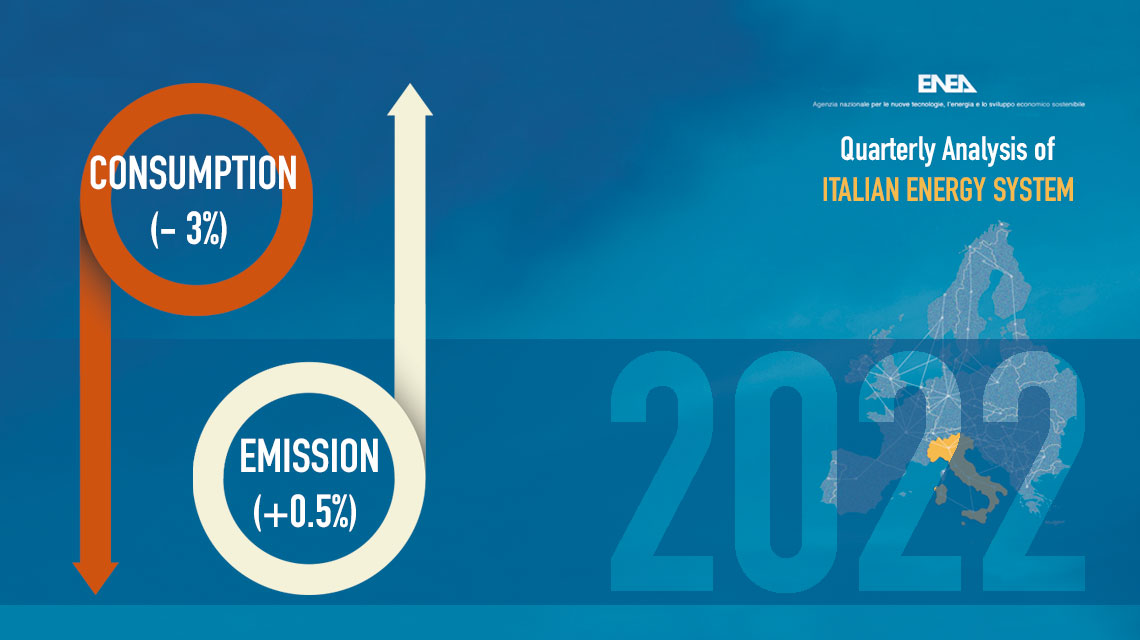Italian National Agency for New Technologies, Energy and Sustainable Economic Development

Energy: ENEA Analysis 2022, energy demand down by 3% CO2 emissions up by 0.5%
Difficult phase for the Italian energy transition (ENEA energy transition index down by 54%)
Share of renewables on final energy up to 20%
2022 will be remembered not only as the year of the parallel gas and electricity crises, with Russian gas flows to Europe halved and prices doubled compared to 2021, but also for the record contraction of Italian energy consumption in the last quarter (-12%), which determined a drop of more than 3% on annual basis (slightly less than the European average, -4%). A positive implication of energy consumption drop was a one percentage point growth in the share of renewable sources, which reached 20% of final consumption. On the other hand, the ISPRED index, which assesses the Italian energy transition on the basis of a set of indicators related to energy prices, CO2 emissions and energy security, recorded a sharp drop (-54%). These are some key results of new ENEA's Quarterly Analysis of the Italian energy system, which also highlights that carbon dioxide emissions recorded the second annual consecutive increase in 2022, even though its growth (+ 0.5%) has been much lower than the +8.5% recorded in 2021.
“As in the rest of the Eurozone the fall in energy consumption in the last quarter was caused by industrial demand destruction (e.g. closure of plants, as indicated by the -6% in industrial production) and adaptation to high prices, by the exceptionally mild weather at the beginning of the winter 2022-2023, as well as by the measures introduced by the policymakers to reduce gas and electricity consumption”, underlines Francesco Gracceva, the ENEA researcher who coordinates the Analysis. “From August 2022 to February 2023, reference period of the European and the National Demand Reduction Plans, gas consumption was 19% lower than the average of the last five years, electricity consumption was 4% lower”.
Due to the robust increase in GDP (+3.7%), in 2022 the energy intensity of the economy decreased by an unprecedented 7%. “This drop has been strongly influenced by contingent factors (first of all the mild weather) but, differently from what we observed in recent years, it seems that since mid-2022 there has been a substantial decoupling between energy demand and its main drivers, such as GDP, industrial production, climate and mobility”, underlines Gracceva.
As regards energy prices, in 2022 electricity prices grew by more than 100% on average, while gas prices increased by 57%. “The price crisis has not been accompanied by a physical supply crisis thanks to the record imports of liquefied natural gas into Europe on one hand, to the sharp drop in energy consumption on the other hand, strongly favored by the mild climate. Since the last quarter of the year these factors combined led to a marked reduction of gas prices, and as consequence of electricity prices, but the equilibrium of the gas market remains fragile. Beyond the short term, high prices remain a serious threat to the competitiveness of European industry, as shown by the strong contraction of industrial production in the two main European manufacturing countries, Germany and Italy”, continues Gracceva.
In terms of primary energy sources, the drop in total energy consumption has been caused by the strong contraction of natural gas (-10%) and renewable energy sources (-12%), not offset by the greater use of oil (+5.5%) and coal (+29%).
The increase in CO2 emissions (+0.5%) despite the drop in energy consumption is primarily attributable to the greater use of coal (and fuel oil) in power generation (+60%), which more than offset the sharp contraction of natural gas consumption. In contrast with recent years emissions grew only in ETS sectors (power generation and energy-intensive industry, +5.5%), while those of non-ETS sectors (non energy intensive industry, residential and commercial, transportation, agriculture) decreased by 2.5%.
As regards the energy transition index ISPRED (Index Security and Prices of Energy supply and Decarbonization), the 54% drop was caused by the worsening of the indicators related to its Price and Decarbonisation components, while those of its Security of supply component had only a marginal decline.
“The National Gas Demand Reduction Plan and the record high energy prices have reduced gas and electricity demand and guaranteed acceptable capacity margins both in gas and the power system, despite the loss of about 1/4 of 2021 gas imports. In short, it seems that decision-makers decided to safeguard energy security even at the cost of accepting negative implications on decarbonisation and energy prices, probably seeing the latter as temporary”, concludes Gracceva.
Some positive signals come from the Italian competitiveness on low-carbon technologies, on electric mobility in particular: the most recent data on patents for accumulators and charging systems show a slight recovery of the delay recorded in past years with respect to the other main European countries. The trade balance in electric vehicles improved as well in 2022. However, overall the Italian trade deficit in low-carbon technologies increased by 14% in 2022, rising to 3,7 billions (0.32% of GDP). The worst performance were related to the imports of PV panels and plug-in hybrid vehicles, as well as of lithium-ion accumulators, which alone account for 56% of the overall trade deficit in low-carbon technologies.
